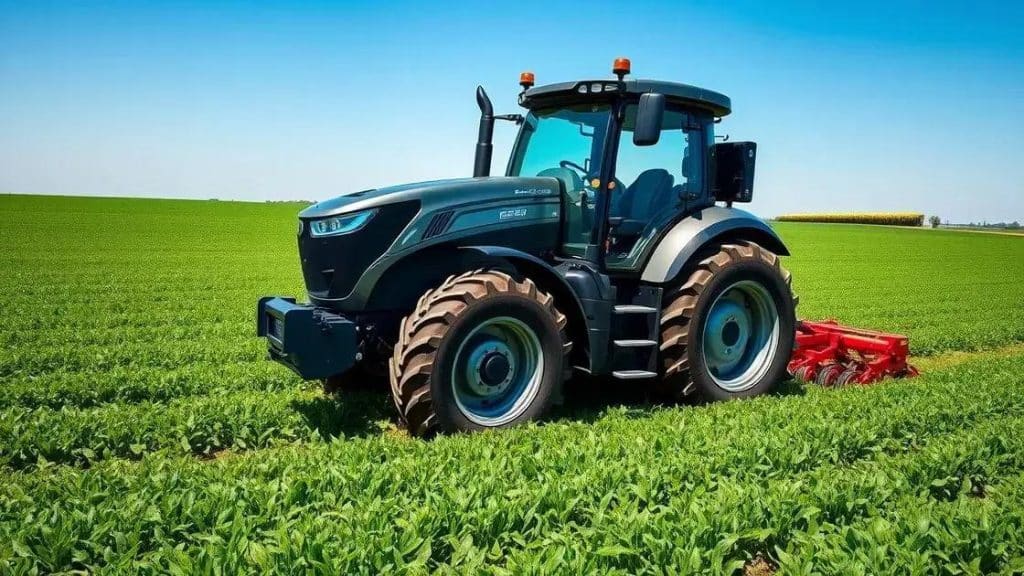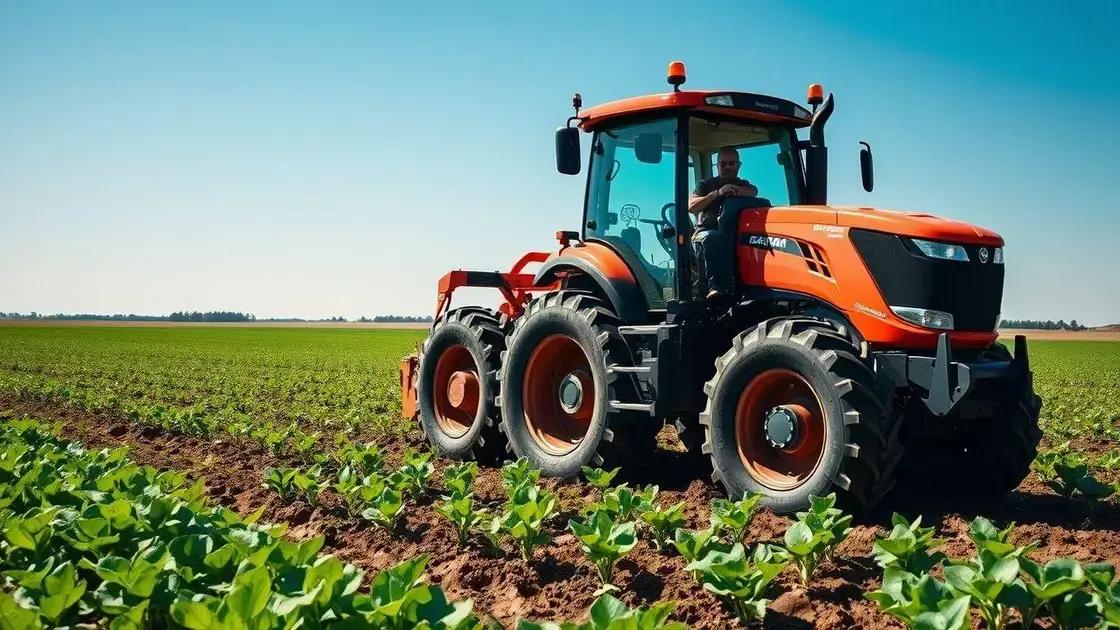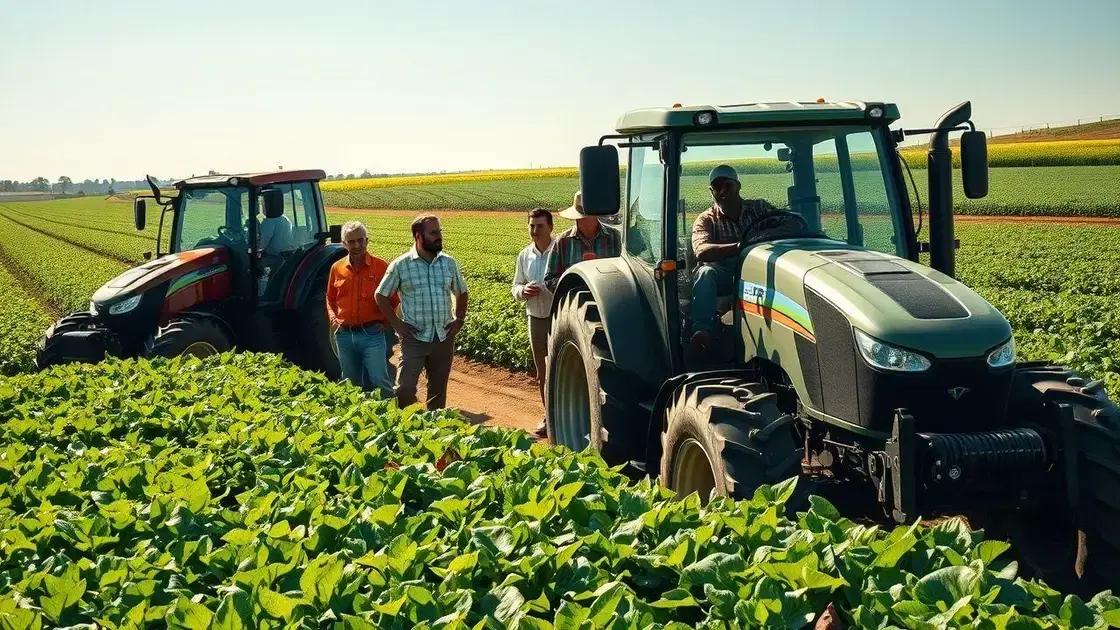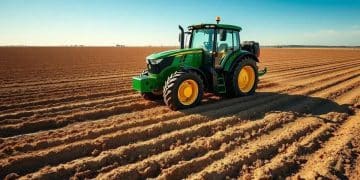GPS-guided tractor steering technology enhances farm efficiency

GPS-guided tractor steering technology enhances farming efficiency by improving accuracy, reducing costs, and promoting sustainable agricultural practices through precise navigation and resource management.
GPS-guided tractor steering technology is changing the landscape of modern farming. Imagine a world where tractors can navigate fields with pinpoint accuracy, saving time and resources. Curious about how it works and its benefits? Let’s dive in!
Understanding GPS-guided tractor steering
Understanding GPS-guided tractor steering is vital for modern agriculture. This technology allows farmers to navigate their fields accurately, which significantly improves productivity. By using satellite signals, tractors can steer themselves with incredible precision.
What is GPS-guided tractor steering?
GPS-guided tractor steering uses a combination of GPS technology and advanced algorithms to automate the steering process. Farmers can enter specific coordinates into the system, allowing the tractor to follow predefined paths in the field. This reduces overlap and ensures that every inch of the field is covered efficiently.
Advantages of GPS-guided steering
- Improved accuracy: With GPS, tractors can operate within 2 to 5 centimeters of the desired path.
- Reduced labor costs: Automation allows for fewer manual tasks, saving time and money.
- Enhanced consistency: Tractors equipped with this technology maintain a steady course, leading to uniform crop growth.
Additionally, the use of GPS-guided tractor steering helps in minimizing fuel consumption. When tractors drive in straight lines without unnecessary overlaps, they use less fuel. This not only saves farmers money but also reduces environmental impact by lowering emissions.
As this technology continues to evolve, its benefits will become even more apparent. Many farmers are seeing significant returns on their investments by integrating GPS-guided steering into their operations. Stories of increased yields and reduced operational costs are common.
Overall, understanding how GPS-guided tractor steering works and its advantages is crucial for anyone looking to modernize their farming techniques.
How it improves precision in farming

Understanding how GPS-guided tractor steering technology improves precision in farming is crucial for modern agriculture. This technology provides farmers with the tools they need to achieve better crop yields and optimize their resources.
Enhancing accuracy in fieldwork
One of the key benefits of GPS-guided steering is enhanced accuracy during field operations. Tractors that use this technology can maintain a straight path within just a few centimeters. This level of precision helps prevent overlapping passes, which can lead to wasted seeds, fertilizers, and pesticides. Farmers can thus save money and improve their bottom line.
Benefits of precision farming
- Resource efficiency: Reduced waste leads to cost savings on seeds and chemicals.
- Uniform crop growth: Consistent planting and treatment ensure that all areas receive equal attention.
- Improved soil health: Precision techniques can minimize soil compaction, promoting better drainage and root development.
Moreover, as tractors navigate fields more accurately, they also help in minimizing soil erosion. This is essential for long-term soil health. By focusing on precision farming, farmers can ensure that they are not just meeting productivity goals, but also managing their environmental impact effectively.
The integration of GPS-guided tractor steering technology enables farmers to collect valuable data from their fields. This data can inform decisions about crop rotation, planting schedules, and resource allocation. With the right information, farmers are better equipped to make strategic choices that enhance their yields.
Overall, the use of this technology underscores a significant shift towards precision agriculture, where each decision is data-driven, and resources are utilized to their fullest potential.
Benefits of adopting GPS-guided technology
Adopting GPS-guided technology in agriculture brings numerous benefits that can revolutionize farming practices. This technology not only enhances efficiency but also contributes to better yield and environmental sustainability.
Cost savings
One of the most significant advantages of using GPS-guided technology is cost savings. Farmers can reduce expenses related to fuel and resources. By minimizing overlap during field operations, they efficiently apply seeds and fertilizers, which directly lowers their costs.
Increased productivity
With the precision offered by GPS-guided systems, farmers can work faster and more efficiently. This leads to increased productivity as tasks that previously took longer can now be completed in shorter time frames. The technology allows for better planning, which optimizes the workflow on farms.
- Improved planning: Accurate field mapping enhances crop planning.
- Better time management: Faster operations lead to more time for other essential tasks.
- Enhanced decision-making: Access to precise data helps farmers make informed choices.
Moreover, adopting GPS-guided technology contributes to sustainable farming practices. By using resources more judiciously, farmers can lessen their environmental impact. This technology allows for targeted applications, reducing runoff and promoting healthier soil.
Farmers who embrace GPS technology often find that it not only improves their operational efficiency but also supports their commitment to sustainable agriculture. Over time, this contributes to better crop rotations and soil management practices, ultimately securing the farm’s future.
Real-life success stories in agriculture

Real-life success stories in agriculture showcase the transformative power of GPS-guided tractor steering technology. Many farmers around the world have adopted this innovation, leading to remarkable improvements in their operations.
Case Study: John’s Farm
In rural Indiana, John implemented GPS-guided technology on his corn and soybean farm. Within the first season, he noticed a 20% decrease in input costs. By minimizing overlap in planting and fertilizer application, John not only saved money but also saw a significant boost in his yield. His corn yielded 15% more than previous years. This success inspired him to share his experiences with local farming groups.
Efficiency Boost: Sarah’s Vineyard
Sarah operates a vineyard in California and wanted to enhance the quality of her grapes. After incorporating GPS-guided steering into her equipment, she achieved greater precision in her planting and irrigation. This resulted in improved grape quality and optimum harvest timing. Sarah reported that her labor costs decreased by nearly 30% due to the automation of her processes.
- Increased yields: Enhanced crop quality leads to better revenue per harvest.
- Reduced waste: Efficient use of resources minimizes environmental impact.
- Community sharing: Success stories inspire others to adopt new technologies.
Moreover, local workshops and demonstrations have emerged, where these successful farmers share their stories. They explain how adopting GPS-guided tractor steering technology has not only benefited their farms but has also fostered community collaboration. As more farmers hear these stories, many are eager to try the technology for themselves. This trend reflects a growing commitment to innovation in agriculture.
As we see more farms embracing these advancements, the potential for improved agricultural practices continues to expand. Success stories like John’s and Sarah’s serve as a beacon of hope for many in the industry, emphasizing that change can lead to sustainable and profitable practices.
FAQ – Frequently Asked Questions about GPS-guided Tractor Steering Technology
What is GPS-guided tractor steering technology?
GPS-guided tractor steering technology allows tractors to navigate fields with high precision using satellite signals, improving accuracy in farming tasks.
How can GPS technology save costs for farmers?
By minimizing overlap during planting and resource applications, GPS technology reduces waste, leading to significant cost savings on seeds, fertilizers, and fuel.
What are some real-life examples of successful GPS adoption?
Farmers like John and Sarah have reported increased yields and reduced costs after adopting GPS-guided steering, showcasing the technology’s effectiveness.
Does GPS-guided steering improve environmental sustainability?
Yes, this technology promotes more efficient resource use, which helps reduce runoff and supports healthier soil management practices.





